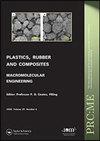四硅氧基硅氧烷对山梨醇衍生物成核聚丙烯薄膜性能的影响
IF 1.2
4区 材料科学
Q3 MATERIALS SCIENCE, COMPOSITES
引用次数: 1
摘要
成核剂导致结晶温度升高,使得高取向薄膜的生产变得更加困难。以1,3:2,4-二(3,4-二甲基苄基)山梨醇(DMDBS)和四硅氧基硅氧烷(phPOSS)为成核体系,对等规聚丙烯(iPP)进行了改性。制备并分析了具有不同引水比(4.8,9.7,14.5)的定向薄膜。测定了它们的机械性能、摩擦系数、热性能和结构以及光泽度、雾度和透明度等光学性能。用偏振光傅里叶变换红外光谱法测定了薄膜的大分子取向。该成核体系使薄膜具有优异的机械性能和光学性能,并具有较高的取向能力。与iPP相比,DMDBS和phPOSS的应用可使断裂时的穿透载荷增加26%,杨氏模量增加70%。可以认为DMDBS/phPOSS体系是聚丙烯薄膜生产中一种有效的改性剂。本文章由计算机程序翻译,如有差异,请以英文原文为准。
Effect of tetrasilanolphenyl silsesquioxane on properties of sorbitol derivative-nucleated polypropylene cast films
ABSTRACT Nucleating agents cause an increase in crystallization temperature, making the production of highly oriented films much more difficult. In this study, a nucleating system composed of 1,3:2,4-bis(3,4-dimethylbenzylidene) sorbitol (DMDBS) and tetrasilanolphenyl silsesquioxane (phPOSS) was used to modify isotactic polypropylene (iPP). Oriented films characterised by different draw drown ratios (4.8, 9.7, 14.5) were prepared and analysed. Their mechanical properties, coefficient of friction, thermal properties, and structure as well as optical properties such as gloss, haze, and transparency, were also determined. The macromolecular orientation of films was tested by polarised light Fourier transform infrared spectroscopy. The proposed nucleating system provides films with superior mechanical and optical properties, which are accompanied by high orientation ability. The application of DMDBS and phPOSS allowed a 26% increase in penetration load at break and Young modulus by 70% compared to iPP. It can be assumed that DMDBS/phPOSS system is an efficient modifier for polypropylene film production.
求助全文
通过发布文献求助,成功后即可免费获取论文全文。
去求助
来源期刊

Plastics, Rubber and Composites
工程技术-材料科学:复合
CiteScore
4.10
自引率
0.00%
发文量
24
审稿时长
4 months
期刊介绍:
Plastics, Rubber and Composites: Macromolecular Engineering provides an international forum for the publication of original, peer-reviewed research on the macromolecular engineering of polymeric and related materials and polymer matrix composites. Modern polymer processing is increasingly focused on macromolecular engineering: the manipulation of structure at the molecular scale to control properties and fitness for purpose of the final component. Intimately linked to this are the objectives of predicting properties in the context of an optimised design and of establishing robust processing routes and process control systems allowing the desired properties to be achieved reliably.
 求助内容:
求助内容: 应助结果提醒方式:
应助结果提醒方式:


